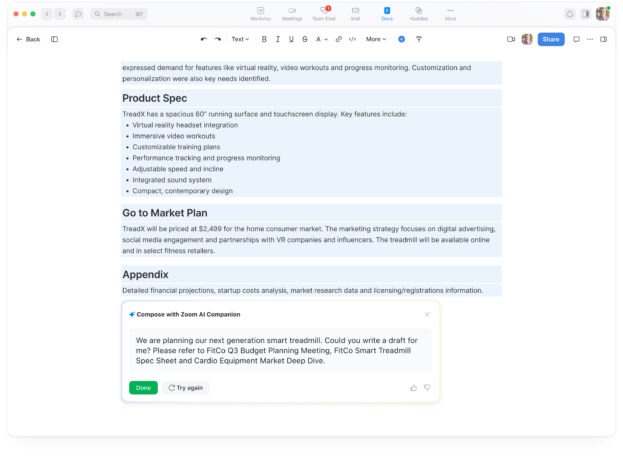- | 9:00 am
For Zoom’s CEO, AI is critical—but the basics matter most
As the video collaboration kingpin beefs up its AI Companion and adds new tools such as Zoom Docs, it’s got to keep things simple, says CEO Eric Yuan.

If you only started paying attention to AI’s potential to transform productivity last November 30—the day OpenAI announced ChatGPT—you have an awful lot of company. But Zoom founder and CEO Eric Yuan says his AI epiphany dates back several years.
“Around the end of 2019, after we became a public company, we [asked ourselves], ‘Hey, what’s next?’” Yuan says. Two emerging technologies rose to the top of the list: augmented reality and artificial intelligence. Progress in AR was contingent on advances in hardware that are not exactly coming at a breakneck pace. AI, however, is turning out to make remarkable things possible more quickly than even the field’s optimists might have guessed.
But more than the average AI enthusiast, Yuan also emphasized the importance of integrating new features in thoughtful ways that don’t diminish what people liked about a product in the first place.
“Don’t make [the product] clunky,” he said. “Don’t lose the stability. Don’t lose the simplicity. That’s sort of the oxygen of our business. And then you can add more stuff—but if you lose the foundation, nobody cares.”

Like other generative AI assistants, Zoom’s AI Companion can draft business documents.
Stability and simplicity quickly made Zoom a favorite when it entered the market in 2011, even though it was a newcomer in a field already thickly populated with other video-calling apps. When COVID-19 suddenly made collaboration-by-webcam a necessity, Zoom became the era’s iconic tech product. And then, as the pandemic subsided, the company worked to prove that it was a full-service provider of productivity products, not a one-trick pony. At last year’s Zoomtopia, it even introduced email and calendar apps.
Now that generative AI is becoming a prerequisite for productivity products of all sorts, Zoom’s next challenge is showing that it can implement the technology at least as well and as broadly as anyone else. It calls its prompt-driven assistant the AI Companion and is rolling out features that let it summarize meetings in progress, catch users up on chat threads, draft documents and emails, help break down ideas visually in Zoom’s whiteboarding app, and more.
Rather than building its AI from scratch or relying solely on one large language model provided by someone else, Zoom is using what it calls a federated model. It built the AI Companion on some of its own algorithms, but is also weaving in LLMs from OpenAI, Anthropic, and Meta, mixing and matching them in different ways in varying contexts.
Placing bets on multiple technologies might help the company better compete with Microsoft and Google, two of the world’s most resource-rich AI powerhouses. But the approach also helped it give the AI Companion one of its most obviously appealing features: It’s included with paid Zoom plans. That’s compared to the additional $30 per user per month that Microsoft plans to charge Microsoft 365 (née Office) enterprise customers for its AI Copilot when it reaches general availability on November 1.

The AI Companion at work during a Zoom meeting
Given that Zoom faces the stiff challenge of competing directly with Teams, which many organizations already get as part of Microsoft 365, giving paying customers the AI Companion at no extra charge has a script-flipping feel to it. Yuan acknowledges that cheapness alone won’t win the AI war: “Customers are very smart,” he says. “They’re going to compare for sure.” But, he adds, “The feedback [on AI Companion] is very positive.”
Even as Zoom adds more productivity tools to its portfolio, it’s trying to avoid getting into a situation where anyone expects it to take on Microsoft 365 or Google Workspace feature for feature. Like last year’s Zoom Mail and Zoom Calendar, Zoom Docs looks to be a relatively lightweight product that’s deeply integrated with siblings such as Zoom Meetings and Zoom Team Chat in ways that go beyond what a third-party product can achieve. And if customers decide to stick with the collaborative document editor they’re already using, that’s fine too, Yuan says: “Whatever they want to use, that’s fine, as long as we add value.”
As for allying concerns customers might have about AI’s downsides, he says reassuring them that Zoom isn’t using their business data to train its models is essential. But he argues that generative AI’s tendency to hallucinate when asked to be an expert on everything isn’t a major issue in the contexts where Zoom is putting it to work, since it’s focused on “business communications—a meeting or chat conversation or whiteboard, those kind of things. Not some random stuff.”
The current onslaught of AI-based productivity tools is arriving as most organizations are still figuring out just what work will look like in the post-pandemic era. In August, Yuan’s mandate that Zoom’s own employees return to the office two days a week made the news, presumably in part because the idea of a company synonymous with remote work not fully embracing it felt discordant.
He brought up the company’s hybrid policies during his Zoomtopia keynote and, when I asked, pointed out some examples of a physical office presence being essential—“If a customer wants to visit us, saying ‘Oh, sorry, I’m working from home’ doesn’t make any sense.” But he also said that Zoom needs to understand how most of its customers get stuff done to serve them, and that its hybrid policy mirrors that of many organizations.
Which is not to say that he doesn’t think there’s lots of opportunity left to make virtual meetings better. He raves about Apple’s Vision Pro headset—“When I tried that experience a few months ago, it was amazing, because I didn’t feel dizzy”—and its potential to enable a great experience for a service like Zoom. And he says that AI will help the company enable experiences that go far beyond Zoom in its current state.
In fact, Yuan, who’s never afraid to acknowledge that there’s such a thing as Zoom overload, predicts that the day is coming when we’ll be able to share the burden with AI-generated re-creations of ourselves. When that’s possible, and participating in yet another meeting sounds exhausting, “I can send a digital version of myself to join that call,” he says. Maybe not for something important like an earnings call, he clarifies, but for “talking with some friends you already know very well, or customers you already know very well.”
Yuan isn’t predicting when such technology could be ready for mainstream use. He also stresses that even when it is, user acceptance will determine whether it takes off. But he says that the version in Zoom’s labs is “pretty cool, actually.”
Like many things about our AI-infused future, it sounds like it could be too much change, too fast. Still, I’m already fantasizing about just which meetings I’d offload to my own digital doppelgänger someday—and wondering if we’ll live to see the first Zoom meeting attended entirely by fake humans.






































